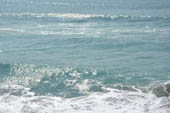
Purpose
To demonstrate how the solar system, specifically the water cycle, produces fresh drinking water through desalination of sea water.
Additional information
Earth's water is in constant motion, with no beginning and no end. The continuous movement of water is referred to as the water cycle, also known as the hydrologic cycle. When water from oceans and other bodies of water is heated by the sun, it causes evaporation. The evaporation condenses into clouds and returns to earth in the form of rain and snow. As the water evaporates, the salt remains in the ocean. When the water returns to earth through precipitation, it's fresh water that's free from salt. This is the water that feeds our fresh water rivers and lakes and provides us with underground well water.
Sponsored Links
Required materials
- Iodized salt (the kind from the grocery store)
- Bottled drinking water (or tap water if bottled water isn't available)
- Heavy ceramic cup or mug
- Large glass bowl (large enough to fit the cup inside)
- Plastic cling wrap
- A rock or small weight
- Sun
Estimated Experiment Time
About 10 minutes to set-up, several hours for the drinking water to form.
Step-By-Step Procedure
- 1. Pour the drinking water into the cup or mug so that it's about 1 inch deep.
- 2. Mix some of the salt into the water. Add enough so the water tastes salty. Note that if you drink some of the water, make sure to re-add water so it's at a depth of about 1 inch.
- 3. Pour the salted water from the cup into the bowl.
- 4. Rinse the cup and dry it, ensuring it's free of any salt residue.
- 5. Place the cup in the center of the bowl.
- 6. Cover the bowl top tightly with your plastic cling wrap. Ensure there are no open spots around the rim.
- 7. Find a safe and clean place that gets LOTS of sunshine, such as on a window sill. Put the bowl down where it can get the most amount of sun.
- 8. Place your rock or weight on top of the plastic wrap, right above the cup. The rock or weight should cause the plastic wrap to sag in the center above the cup. This step is essential to ensuring the water falls into the cup, so make sure it's right.
- 9. Wait several hours.
- 10. Water condensation should form on the underside of the plastic wrap. Where you have your rock / weight placed you should see drops of water formed and flowing downward slowly into your cup. Once the cup has some water in it (there will be a small amount) you can pull back the plastic wrap and remove the cup.
- 10. Drink the water. It's now pure and clean, free from any salt!
Note
If you live near an ocean, you can try this experiment with sea water! Simply skip the steps that call for adding salt (sea water has plenty of salt already) and follow the same directions.
Observation
How is the plastic wrap similar to that of a greenhouse? What if you were to add some food coloring to the salt water. Would the resulting water that forms in the cup still be clear? What do you think would happen if you used tomatoes or melon as a substitute for the salt water?
Result
Water vapors form inside the bowl as the sun warms the water, evaporating it. The plastic wrap acts as a form of greenhouse, trapping the vapor inside and causing the humidity to rise to 100%. The top of the plastic wrap is much cooler because it's in contact with outside air. When the humid air inside rises and touches the top of the plastic wrap (the cooler area), the water vapor condenses and forms water droplets on the under surface of the wrap. As time passes the water droplets around the plastic wrap grow larger and flow to the center of the wrap where the rock is. As the droplets join together, they grow heavier and eventually drop into the cup. The result is pure, clean, fresh drinking water that's devoid of salt!
Sponsored Links
Take a moment to visit our table of Periodic Elements page where you can get an in-depth view of all the elements,
complete with the industry first side-by-side element comparisons!